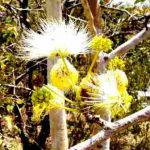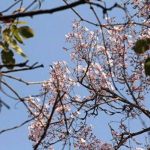TREE LIFE
OCTOBER 1995.
MASHONALAND CALENDAR
Tuesday 3rd October. Botanic Garden Walk at 4.45 for 5 p.m. We will meet Tom in the public car park of the Gardens, where there will be a guard for the cars. We will continue where we left off last month.
Sunday 15th October. As this is the hot month, a not very strenuous day is planned in some pleasant woodland a short distance from Harare, on Mr. and Mrs. Mumford’s farm. Some of the ‘uncommon’ species that occur there are Bolusanthus speciosus, Vepris zambesiaca, Zanthoxylum chalybeum and Securidaca longipedunculata.
Saturday 28th October. Mark’s Walk 3.00 p.m. at Greystone Park Nature Reserve.
Tuesday 7th November. Botanic Garden Walk
MATABELELAND CALENDAR
Friday 29th Sept – Sun. 1st October at Ikoro Safaris.
Monday 9th October. At 7.45 for 8.00 p.m. we will show episode 5 of The Private Life of Plants’ entitled Living Together.
Sunday 5th November. At June Davies’ farm in the Figtree District. All day so bring the necessary sus¬tenance and comforts. Depart from Girls’ College at 8.30 a.m. promptly.
Friday 1st December to Sunday 3rd December. At East Kana Estates, a safari operation on the Falls Road (230km on tar and 10km on dirt). Wonderful botanics and accommodation for 20. First come first served. Phone Ian or Margaret McCausland . (Open to Bulawayo and Harare botanical enthusiasts)
AN INTRODUCTION TO EUCALYPTUS
Approximately 20 members of the Society met at the Forestry Research Centre off Orange Grove Drive on 26th August 1995 for an introductory guided tour by Lyn Mullin to the genus Eucalyptus. The idea was to expand our knowledge of these trees, having had our appetite whetted by Lyn’s recent paper on Eucalypts in
Harare.
Perhaps others, like me, had a rather negative image of this genus in Southern Africa, that of rather sterile woodland in which little of interest grows. But what a wealth of fascinating detail was revealed by Lyn. Indeed, the walk was a remarkable tour-de-force bringing in aspects of the trees’ morphology, their subgeneric and sectional classification, their native habitat and distribution and their application to commercial forestry in Zimbabwe.
There was too much information to reproduce in a short article like this, but would like to mention the remarkable heterophylly shown by (for example) Eucalyptus cinerea (the Silver Dollar Gum) that has three types of leaf. On the one hand, juvenile leaves which are grey, opposite-decussate, sessile, cordate and more or less circular; and on the other, mature leaves, which are green, alternate and long-stalked. In between occurs an intermediate type. After the main walk, a party went on to see Eucalyptus siderophloia near the Runiville Post Office. I had no idea that there were so many and so varied species to be found within Harare.
Our very great thanks to Lyn for opening up a new world for us.
-Mark Hyde
A LETTER FROM WEST VIRGINIA.
On Sunday 3rd of September rather than venturing out into the hot arid and leafless Matabeleland bush, we watched the video The Remnants of Eden that was very good but not really worthy of a report to Tree Life readers. So instead, this month I thought I would share with my fellow dendrophiles a letter recently received from Tom Raub (a Bulawayo member formerly of Bluefield, West Virginia) whilst holidaying in his home state.
-I. Mc C.
“Mary arrived on 20th July, arriving at Miami at 6.00 a.m. – we are now together last 4 days and three days from now, I start back. It rained for 2 weeks daily – when I arrived, flooding basement 2 times, knocking out water heater first, and later washer and dryer. Squirrels got into basement and tore up! – I’ve given 2 lectures and will lecture at hospital in 2 days.
This morning – Sunday – we have full-page write-up with 8 colour photos – in paper. I’ve been invited out to eat almost nightly.
I’ve been studying trees and flowers. The yards in the neighbourhood are storehouses of wild flowers – due to the excessive rains. Dandelions, white and red clover (sweet clover is up on the mountains), heal all (Prunella vulgaris), ground ivy, common yellow wood sorrel (Oxalis sterta), creeping buttercup (Ranunculus repens), broad-leaved plantain, and buckhorn plantain cover these yards, sometimes replacing the grass (mostly Kentucky bluegrass and fescue). Mary has taken me up on East River Mt. 2 times, finding exotic flowers, wild phlox, sun drops, and yarrow. Queen Anne’s lace, bergamot, Jimson weed, crow vetch (Coronilla varia), tassel rue, tassel, Joe-dye weed, soapwort, Turk’s cap lily, and many others – in our back yard, we have a small creek (spruit) – lined with touch-me-not (Impatiens capensis), watercress, and lilies (yellow). White ash trees, honeysuckle, and lilac bushes are in the back. On one side we have a pink flowering crab apple tree and a cherry tree. In the front are 2 large silver maples along with sugar maple. By the side (my den) is a large forsythia bush (in early spring covered completely with yellow flowers). English ivy and hosta cover ground in front of house just started to bloom.
I discovered Solomon’s seal on this venture. Next time I come home (West Virginia), I need to come in April to see the Service-berry and red-bud trees – first to flower, also the fringe tree (Chionanthus virgivicus) – we should try to bring this to Africa (in our back yard); there is a Chionanthus genus in the Bulawayo area.
If you would like to visit our area, we have “The Greenbriar”, rivalling (rivalling is also correct – I looked it up) Victoria Falls Hotel – or Elephant Hills, and we have Pipestem Park with beautiful trees. But most important of all, the area is beautiful with many trees (oaks, maples, pines, buckeyes, birch, poplars, tulip trees, ash, sycamores, sassafras, hornbeam, alders, catalpa, box elder, conifer, and many others). In the autumn the colours of the leaves changing, are un¬paralleled in nature. With my blinders on for 40 years I spent here, I only saw these autumn changes.
All the other wonders, I missed! In the last 2-3 years, I’m trying to make amends by studying the flowers and trees, when I return!
Gosh! I’ve been running my own Tree Society and my own flower society – learning a great deal! There is not enough time to do all the things necessary to accomplish all the things I’m behind on – in regard to nature – will see you folks when I return.
Regards
-Tom Raub
BOTANIC GARDEN WALK: 5 SEPTEMBER
After finishing the Acacias last month, Tom had intended to cover Albizia and the other genera in the subfamily Mimosoideae of the Leguminosae. Unfortunately, by 5.15 p.m., no Tom! So Meg Coates Palgrave stepped into the breach. We are very grateful to her for taking over at very short notice.
Firstly, we looked at the genus Newtonia. Two species occur in Zimbabwe, Newtonia buchananii and Newtonia hildebrandtii and both are trees. Like Albizia, the plants are unarmed but they lack the gland on the leaf rhachis that is present in Albizia. Furthermore, the pods of Newtonia remain fused down one side and the seeds are winged. In Albizia, both sides of the pod split and the seeds are unwinged.
There are some magnificent Newtonia buchananii in the Botanic Gardens. This tree is an Eastern Districts species, occurring for example near the Mtarazi Falls. Newtonia hildebrandtii on the other hand is more of a low altitude species. The Tree Society recently saw it in Willy Reid’s garden on the banks of the Zambezi at Chirundu. There was general agreement amongst those present that the two would never grow together in the wild.
Next, a tricky trio of Albizia species was discussed, namely Albizia gummifera, Albizia adianthifolia and Albizia schimperiana. Albizia gummifera has smooth bark, a very asymmetrical leaf base with a small ‘heel’ and occurs in moist high altitude forest (for example, the Vumba).
Albizia schimperiana has a more or less rounded leaf base and grows in drier types of forest (for example, at Cecil Kop). Albizia adianthifolia is a species of low altitude forest, has a generally rough bark and lacks the little ‘heel’ of Albizia gummifera. After a general discussion about Albizia species out¬side the Herbarium, we moved on to Albizia versicolor. Although more or less completely leafless, a few of the large furry leaflets were found together with some of the typical flat pods of the genus Albizia. Nearby, was a Xylia torreana. This has only 1 pair of pinnae with a huge gland at the point where the pinnae join the rhachis. The pods stand upright and are thick and woody, almost like a Baikiaea.
Finally, in the fading light we looked at a Scotsman’s Rattle, Amblygonocarpus andongensis, famous from the platform at Victoria Falls Railway Station. This is another unarmed tree, with no glands on the rhachis and completely hairless. The pods are square in cross-section and as the name suggests, the ripe seed rattle when the pods are shaken.
Many thanks to Meg who was a remarkable impromptu guide.
-Mark Hyde
NYARUPINPA CATCHMENT
Retrospect.
The interval since my last letter to you 15/3/95 has been joyous because of the birth of the sixth grandchild, the first grandson, Ralph. This was followed by a spell in St. Anne’s and Avenues and convalescence in Harare for my liege, who thanks members of the Tree Society for visiting him. Now he is much better and we are home again, Deo Gratias.
Lambiris, A.J.L. – The Frogs of Zimbabwe 247 pp., illustrated, Lira 70 000 plus postage – surface mail Lira 3 650; airmail Lira 10 150. The address for this ‘pubblicazione’
Museo Regionale Di Scienze Naturali
Via Giolitti,
36-10123 TORINO ITALY.
There is a note on the museum publications catalogue, which informs prospective purchaser that ‘if you confirm your order we will send you the book with the invoice, thank you’. It is good to know that they trust us. In due course we will read about the Grey Tree Frogs which sometimes almost become part of the household, an individual will come, stay on a windowsill or verandah pillar and feed on insects attracted to the lights at night. Its presence is missed when it departs of its own accord.
February is Fungi Month.
Along time ahead but be ready to give them more than a casual glance. There are fungi to be seen in the dry season, these are the woody bracket fungi found on bark and constructions made of wood. A died-back twig of Acacia bore a troop of miniature white cups, easily overlooked.
The wild mushrooms collected in this garden in February could have belonged to the genus Russula. Catherine Sharp will confirm their identity when fresh young specimens are available next year.
Vegetables and Fruit in Season
The Civet (s) has come back to the midden near the dam. This heap was abandoned when the millipede season ended. Its use was resumed in May, Parinari fruits, and peanuts and more recently countless fig seeds comprise the dung. There are signs of coarse-ground mealies in the diet. Wads of undigested grass are characteristic of ci vet droppings. The midden contained Senna seeds yesterday.
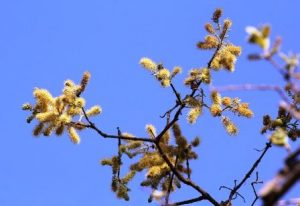
Combretum molle. Photo: Bart Wursten. Source: Flora of Zimbabwe
Combretum flower scent is associated with the months of August and September, the sound of bees made me aware that Combretum molle was their source of food. Many readers will recall that Combretum adenogonium ’s old name was Combretum fragrans.
A Showpiece
An ecological curiosity is the adjacency of a Blue Waxbill’s nest and a social wasp’s nest, daytime predators of the Waxbill beware, and night predators are safe. In this garden beside the main gate a spindly Ormocarpum kirkii supports these nests. The opening of the bluey’s nest faces north.
“Madam, come see”
“OH! It looks like a black mongoose”. Jesse must have caught it inside the fence last night, she barked a lot. The animal has 5 toes on each foot; its mass is approximately 4kg. It failed to get under the fence, moved a lot of gravel, gave up and climbed over the 3 metre high fence?…
Impending Journey
Europe is being lashed by storms; we fly out tonight to UK.
-Benedicta Graves
20TH AUGUST 1995 HARARE OUTING TO NGOMOKURIRA. CHINAMORA COMMUNAL LANDS.
This month saw Harare members revisiting Ngomakurira, which we had last visited in 1992. This location is always worth a visit even if you don’t stop to look at the trees, for the enormous granite dome and the rock paintings on the sheer wall on the one side of the cleft in the rock on the way up is always awe inspiring.
I suppose it was predictable that the long-suffering write-up writers of Harare would see relief on the horizon when the Haxen’s bakkie (correction pickup!) hove in sight. Sure enough, as soon as I alighted from the vehicle, Andrew MacN pounced, saying “Would you mind……?” Well, O.K.
How nice it was to see again so many of our friends of old, in addition to the sprinkling of new faces. Having only recently returned from the Cape I was interested to see whether I would be able to think of the names of any trees at all or whether I’d just identify them as Erica/Protea/Restio sp.! Fortunately, with the help of a few of the bright sparks in the Tree Soc. to recharge the battery, the old brain was kick-started into life and although spluttering somewhat here and there, I was pleasantly surprised to see that quite a few of the tree names were still in there! The plan was that we would put the ‘blinkers’ on and head quickly up to the top of the hill to look at what was there, and then park off (or ‘mellow out’ as they say in CT) at the summit for lunch. But blinkers or not there were still a number of trees on the way up which could not escape one’s attention. Immediately after leaving the car park, a few smallish Heteropyxis dehniae, or lavender trees were en¬countered. It was interesting to note that even though the trees were visibly drought stricken, the crushed leaves still gave off their delightful scent.
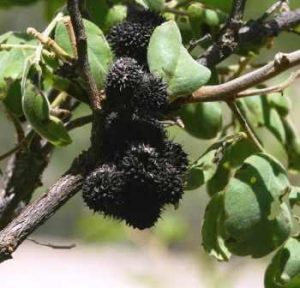
Dalbergia nitidula. Photo: Bart Wursten. Source: Flora of Zimbabwe
A little further up the brain spluttered as the leafless tree which I recognized from its bark as Commiphora africana turned out in fact to be none other than Euphorbia matabelensis, complete with Euphorbia style flowers and the zigzag branches which make the tree so inexcusably recognizable. Not far from this my little party was attracted by a splash of white flowers that turned out to be the somewhat short-lived blossoms of Dalbergia nitidula, the poor cousin of Dalbergia melanoxylon. This is because the latter is the well-known ebony or Blackwood, whilst the former, which is what we saw, is known as the purple-wood and has an inferior timber. I use the term ‘ebony’ shamelessly even though it is not a member of the Ebenaceae family, because did you know that it was Dalbergia melanoxylon which introduced Europe to ebony when it was imported from Africa via the Nile in Roman or even pre-Roman times? The word ebony was derived from the local name for the tree where it grew in Ethiopia or thereabouts. Only after the European explorers (Da Gama, etc.) headed to the East was the ebony found which gave the name to the Ebenaceae family, and this was because the wood was also hard, heavy and black like the previously known ebony, Dalbergia melanoxylon. Also close to the Dalbergia nitidula was a reasonably sized Bridelia cathartica with much fruit draped over the drooping ‘bridal’ veil twiglets.
Closer to the top was a small stand of well-sized waterberries, Syzygium guineense that offered welcome shade to some of the more child-encumbered members of the party who decided that this was just the place for lunch. On the edge of this stand was an unusually tall Protea gaguedi prompting a few nostalgic memories of the Western Cape. (Wouldn’t it be nice if Tree Soc. could visit that place one day?). The needs of children and lunch and time spent catching up on news and gossip meant that I didn’t spend as much time up top as I would have liked to have done. Nonetheless I managed to see some large bushes/trees of Erythroxylum emarginatum. Most of the leaves were indeed ’emarginate’, i.e. with a tiny notch at the tip of each leaf. Also useful is the rolled-under leaf margin and the snap, crackle and pop as the leaf is bent over backwards.
A slight diversion from trees, it was interesting to note there must have been some rain in the last week or so, for not only was there water in some of the rock pools, but many of the resurrection plants, Myrothamnus flabellifolius had changed colour from the usual dull black-brown to bright green. So, added to the day-glow yellow lichen on the rocks, there was quite a bit of fresh colour about. Also just below the ‘tree level’ was a pretty flower on a practically leafless stem/small trunk. This many of us dismissed as the usual Tetradenia riparia the so-called ginger bush but sharper eyes were able to discern that this was in fact Plectranthus sanguineus. The scholars amongst you, of whom there are many, will note that the specific name relates to blood, and this is because the flower will produce a reddish orange stain if crushed between one’s fingers. Only after very close examination it was observed that it is indeed the pollen on the anthers that had a bright orange colour, which resulted in an almost blood red stain when the flower is crushed between one’s fingers. Hence the name. Another of the ‘non-trees’ seen was on the way up, at a small stream crossing was a spindly bush/scrambler with spherical green fruits which I struggled to fit in to the Rubiaceae trees, but couldn’t come up with a name. Only later was I put out of my misery by some of the sager fundis who labelled it as Mussaenda arcuata (I’d have known it if only it had had flowers). Looking at Plowes & Drummond’s Wild Flowers of Rhodesia I see that I wasn’t too far off the mark as it is indeed in the Rubiaceae family, but although described as a bush with scrambling or arching branches, it doesn’t quite qualify as a tree it seems. It apparently occurs mainly on the eastern border mountains, “but also along streams and in relict forest patches in northern Mashonaland and in the Binga district”. Back to trees.
Up near the summit in an area of broken rock dominated largely by more Dalbergia nitidula, we encountered one of the ‘specials’ predictably perhaps; this was another of the Rubiaceae, rejoicing in the new name Tricalysia ruandensis (presumably first described from that topical strife-torn country Rwanda) (formerly Tricalysia congesta). When looking at this I must say I could see little different from the more common Tricalysia niamniamensis (formerly Tricalysia angolensis), having the same tiny axillary flower buds often arranged in threes. The Book seems to key them out on the basis that Tricalysia niamniamensis has hairs on the leaves, sometimes only on the veins on the under surface whereas Tricalysia ruandensis is without hairs. Up on the hill there were a number of old granite kopjie friends such as Tapiphyllum velutinum, Rhus leptodictya, Euphorbia griseola, Steganotaenia araliacea and on the lower slopes some fine mountain ‘acacias’, Brachystegia glaucescens. Although not special kopjie material, I think we were all pleased to see the winter flowering ‘cassia’ Senna singueana and though less gaudy the Turraea nilotica was also worth a close look, as the flower structure is quite intriguing. On a lower rock outcrop was a scattered collection of well-proportioned violet trees, Securidaca longipedunculata, which although not in flower, were given away by the winged rotor-blade seedpods. Nearer the bottom was a large example of the liana Adenia gummifera, giving away its identity by its poison-green trunk. Sadly, this fine specimen had been vandalized and chopped asunder. Lower still was the phenomenon which had been observed in several places around Harare, that is that there were Monotes glaber and Monotes engleri growing together in the same habitat. What accounts for this? Monotes glaber is the one with the yellow-green leaves with the same colour on both sides of the leaf, and Monotes engleri is discolourous, i.e. with a pale whitish underside to the leaf, which is an olive-green on the upper surface. Both have the giveaway extrafloral nectary at the base of the upper surface of the leaf.
I missed many of the special trees that I know occur at Ngomakurira, and the one I really wanted to see was not missed by some of the others. This was Oxyanthus speciosus, which was promised in Tree Life in the August issue, being yet another member of the Rubiaceae family with largish dark green opposite leaves, complete with inter-petiolar stipules which are a feature of the family, and rugger-ball shaped dark green fruits about 2cm in length
Our thanks go to Raymond Mwanaka who very kindly guided us around the area and showed us some of the special features of the hill, more particularly the recently discovered cave.
-Phil Haxen
ALBIZIOSIS
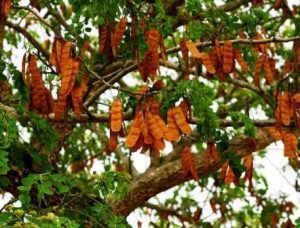
Albizia tanganyicensis. Photo: Bart Wursten. Source: Flora of Zimbabwe
The pods of Albizia versicolor (poison pod Albizia) and Albizia tanganyicensis (Paper Bark Albizia) are the cause of fatal Albiziosis in cattle and sheep during the winter and early spring months.
The trees flower from August to November. The flowers are characteristically half-spherical fluffy ‘powder puffs’; in the case of Albizia versicolor they occur after the new leaves form whereas in Albizia tanganyicensis they emerge before the leaves (as for Albizia anthelmintica). The large pods ripen only in September and October of the following year. Young pods that are dislodged from the trees by high winds are particularly toxic. The seeds are slightly less toxic than the pod case itself. Drying of the young seed reducers its toxicity by about half. As little as 579 gm to 1.14 kg of Albizia versicolor pods have been proven fatal to a yearling steer.
The poison has been identified as 4-methoxy derivative of pyridoxine. The toxic ingredient has a very similar chemical structure to Vitamin B6 (pyridoxine) and trials on guinea pigs have revealed that the use of high doses of Vitamin B6 may be of both prophylactic and curative value in Albizia toxicosis in livestock.
The symptoms include hypersensitivity, a staggering gait and intermittently falling down in convulsions. Breathing is laboured. Frequently the animals die so rapidly that no previous signs of illness are observed. In these cases the ground around the animal may show evidence of severe struggling.
Post mortem diagnosis depends on finding remnants of the pods and seeds in the rumen contents. Albiziosis in cattle can appear very similar to poisoning with chlorinated hydrocarbons, Sarcostemma viminale and heartwater, a rickettsial disease transmitted by ticks.
-Karl van Laeren
ANDY MACNAUGHTAN CHAIRMAN


